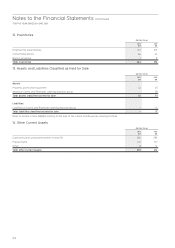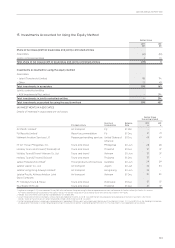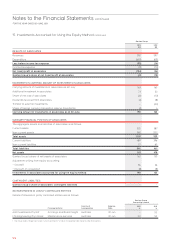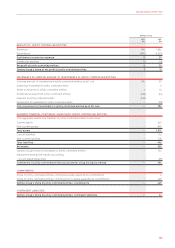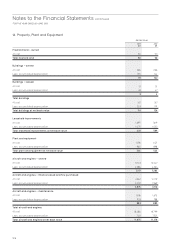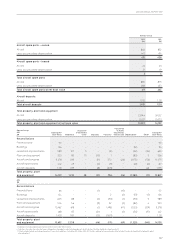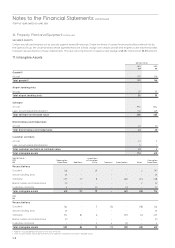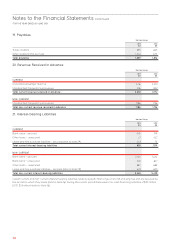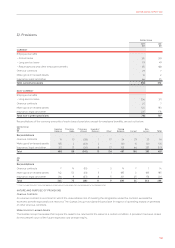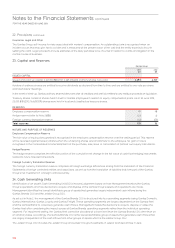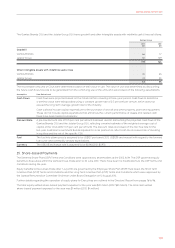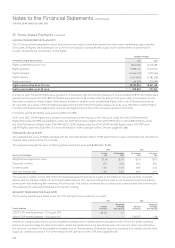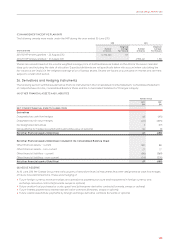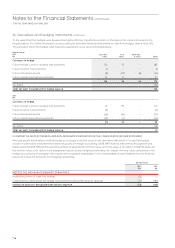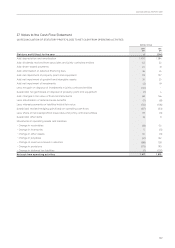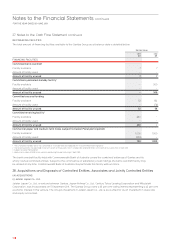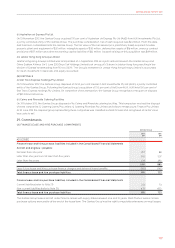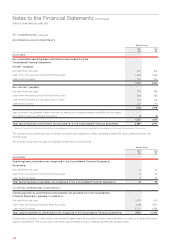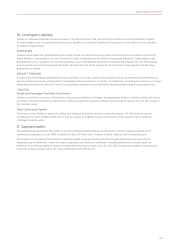Qantas 2013 Annual Report Download - page 134
Download and view the complete annual report
Please find page 134 of the 2013 Qantas annual report below. You can navigate through the pages in the report by either clicking on the pages listed below, or by using the keyword search tool below to find specific information within the annual report.
132
Insurance, Legal and Other
The Qantas Group self-insures for risks associated with workers’ compensation. An outstanding claim is recognised when an
incident occurs that may give rise to a claim and is measured at the present value of the cost that the entity expects to incur in
settling the claim. Legal provisions include estimates of the likely penalties to be incurred in relation to claims and litigation in the
normal course of business.
23. Capital and Reserves
Qantas Group
2013
$M
2012
$M
ISSUED CAPITAL
Issued and paid-up capital: 2,241,745,788 (2012: 2,265,123,620) ordinary shares, fully paid 4,693 4,729
Holders of ordinary shares are entitled to receive dividends as declared from time to time and are entitled to one vote per share
at shareholders’ meetings.
In the event of wind-up, Qantas ordinary shareholders rank after all creditors and are fully entitled to any residual proceeds on liquidation.
Treasury shares consist of shares held in trust for Qantas employees in relation to equity compensation plans. As at 30 June 2013,
23,055,878 (2012: 16,629,559) shares were held in trust and classied as treasury shares.
RESERVES
Employee compensation reserve 49 48
Hedge reserve (refer to Note 26(B)) 123 41
Foreign currency translation reserve (44) (53)
Total reserves 128 36
NATURE AND PURPOSE OF RESERVES
Employee Compensation Reserve
The fair value of equity plans granted is recognised in the employee compensation reserve over the vesting period. This reserve
will be reversed against treasury shares when the underlying shares vest and transfer to the employee. No gain or loss is
recognised in the Consolidated Income Statement on the purchase, sale, issue or cancellation of Qantas’ own equity instruments.
Hedge Reserve
The hedge reserve comprises the effective portion of the cumulative net change in the fair value of cash ow hedging instruments
related to future forecast transactions.
Foreign Currency Translation Reserve
The foreign currency translation reserve comprises all foreign exchange differences arising from the translation of the Financial
Statements of foreign controlled entities and associates, as well as from the translation of liabilities that form part of the Qantas
Group’s net investment in a foreign controlled entity.
24. Cash Generating Units
Identication of an asset’s Cash Generating Unit (CGU) involves judgement based on how Management monitors the Qantas
Group’s operations and how decisions to acquire and dispose of the Qantas Group’s assets and operations are made.
Management identies the lowest identiable group of assets that generates largely independent cash inows being the
Qantas Brands CGU and the Jetstar Group CGU.
As set out in Note 2, the management of the Qantas Brands CGU is structured into four operating segments being Qantas Domestic,
Qantas International, Qantas Loyalty and Qantas Freight. These operating segments are largely dependent on the Qantas eet
and the Qantas Brand to collectively generate cash inows. Management makes the decisions to acquire, dispose or utilise the
Qantas eet after considering the impact across all Qantas Brands operating segments rather than the individual operating
segment. For impairment testing, the Qantas eet cannot be allocated at a lower level than the Qantas Brands CGU other than on
an arbitrary basis. Accordingly, the Qantas Brands CGU is the lowest identiable group of assets that generates cash inows that
are largely independent of the cash inows from other groups of assets which is the Jetstar Group CGU.
The Jetstar Group CGU includes the Jetstar Group and Jetstar Group’s investments in Jetstar branded airlines in Asia.
Notes to the Financial Statements continued
FOR THE YEAR ENDED 30 JUNE 2013
2
2. Provisions continue
d


